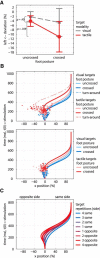Reach Trajectories Characterize Tactile Localization for Sensorimotor Decision Making
- PMID: 26446218
- PMCID: PMC6605379
- DOI: 10.1523/JNEUROSCI.1873-14.2015
Reach Trajectories Characterize Tactile Localization for Sensorimotor Decision Making
Abstract
Spatial target information for movement planning appears to be coded in a gaze-centered reference frame. In touch, however, location is initially coded with reference to the skin. Therefore, the tactile spatial location must be derived by integrating skin location and posture. It has been suggested that this recoding is impaired when the limb is placed in the opposite hemispace, for example, by limb crossing. Here, human participants reached toward visual and tactile targets located at uncrossed and crossed feet in a sensorimotor decision task. We characterized stimulus recoding by analyzing the timing and spatial profile of hand reaches. For tactile targets at crossed feet, skin-based information implicates the incorrect side, and only recoded information points to the correct location. Participants initiated straight reaches and redirected the hand toward a target presented in midflight. Trajectories to visual targets were unaffected by foot crossing. In contrast, trajectories to tactile targets were redirected later with crossed than uncrossed feet. Reaches to crossed feet usually continued straight until they were directed toward the correct tactile target and were not biased toward the skin-based target location. Occasional, far deflections toward the incorrect target were most likely when this target was implicated by trial history. These results are inconsistent with the suggestion that spatial transformations in touch are impaired by limb crossing, but are consistent with tactile location being recoded rapidly and efficiently, followed by integration of skin-based and external information to specify the reach target. This process may be implemented in a bounded integrator framework.
Significance statement: How do you touch yourself, for instance, to scratch an itch? The place you need to reach is defined by a sensation on the skin, but our bodies are flexible, so this skin location could be anywhere in 3D space. The movement toward the tactile sensation must therefore be specified by merging skin location and body posture. By investigating human hand reach trajectories toward tactile stimuli on the feet, we provide experimental evidence that this transformation process is quick and efficient, and that its output is integrated with the original skin location in a fashion consistent with bounded integrator decision-making frameworks.
Keywords: foot; limb crossing; motor control; remapping; touch.
Copyright © 2015 the authors 0270-6474/15/3513648-11$15.00/0.
Figures




Similar articles
-
Towards explaining spatial touch perception: Weighted integration of multiple location codes.Cogn Neuropsychol. 2016 Feb-Mar;33(1-2):26-47. doi: 10.1080/02643294.2016.1168791. Epub 2016 Jun 21. Cogn Neuropsychol. 2016. PMID: 27327353 Free PMC article. Review.
-
Flexibly weighted integration of tactile reference frames.Neuropsychologia. 2015 Apr;70:367-74. doi: 10.1016/j.neuropsychologia.2014.10.001. Epub 2014 Oct 19. Neuropsychologia. 2015. PMID: 25447059
-
Somatosensory saccades reveal the timing of tactile spatial remapping.Neuropsychologia. 2011 Sep;49(11):3046-52. doi: 10.1016/j.neuropsychologia.2011.07.005. Epub 2011 Jul 18. Neuropsychologia. 2011. PMID: 21782835
-
Movement Induces the Use of External Spatial Coordinates for Tactile Localization in Congenitally Blind Humans.Multisens Res. 2015;28(1-2):173-94. doi: 10.1163/22134808-00002485. Multisens Res. 2015. PMID: 26152057
-
Tactile remapping: from coordinate transformation to integration in sensorimotor processing.Trends Cogn Sci. 2015 May;19(5):251-8. doi: 10.1016/j.tics.2015.03.001. Epub 2015 Apr 2. Trends Cogn Sci. 2015. PMID: 25843541 Review.
Cited by
-
Towards explaining spatial touch perception: Weighted integration of multiple location codes.Cogn Neuropsychol. 2016 Feb-Mar;33(1-2):26-47. doi: 10.1080/02643294.2016.1168791. Epub 2016 Jun 21. Cogn Neuropsychol. 2016. PMID: 27327353 Free PMC article. Review.
-
A Conceptual Model of Tactile Processing across Body Features of Size, Shape, Side, and Spatial Location.Front Psychol. 2019 Feb 26;10:291. doi: 10.3389/fpsyg.2019.00291. eCollection 2019. Front Psychol. 2019. PMID: 30863333 Free PMC article. Review.
-
No Evidence for a Role of Spatially Modulated α-Band Activity in Tactile Remapping and Short-Latency, Overt Orienting Behavior.J Neurosci. 2020 Nov 18;40(47):9088-9102. doi: 10.1523/JNEUROSCI.0581-19.2020. Epub 2020 Oct 21. J Neurosci. 2020. PMID: 33087476 Free PMC article.
-
Task demands affect spatial reference frame weighting during tactile localization in sighted and congenitally blind adults.PLoS One. 2017 Dec 11;12(12):e0189067. doi: 10.1371/journal.pone.0189067. eCollection 2017. PLoS One. 2017. PMID: 29228023 Free PMC article.
-
Investigating the Speed and Accuracy of Human Movement Corrections to Visual, Somatosensory, and Tactile Perturbations: Evidence for Distinct Sensorimotor Processes.eNeuro. 2025 Apr 10;12(4):ENEURO.0548-24.2025. doi: 10.1523/ENEURO.0548-24.2025. Print 2025 Apr. eNeuro. 2025. PMID: 40107720 Free PMC article.
References
-
- Badde S, Röder B, Heed T. Multiple spatial representations determine touch localization on the fingers. J Exp Psychol Hum Percept Perform. 2014b;40:784–801. - PubMed
Publication types
MeSH terms
LinkOut - more resources
Full Text Sources
Research Materials
